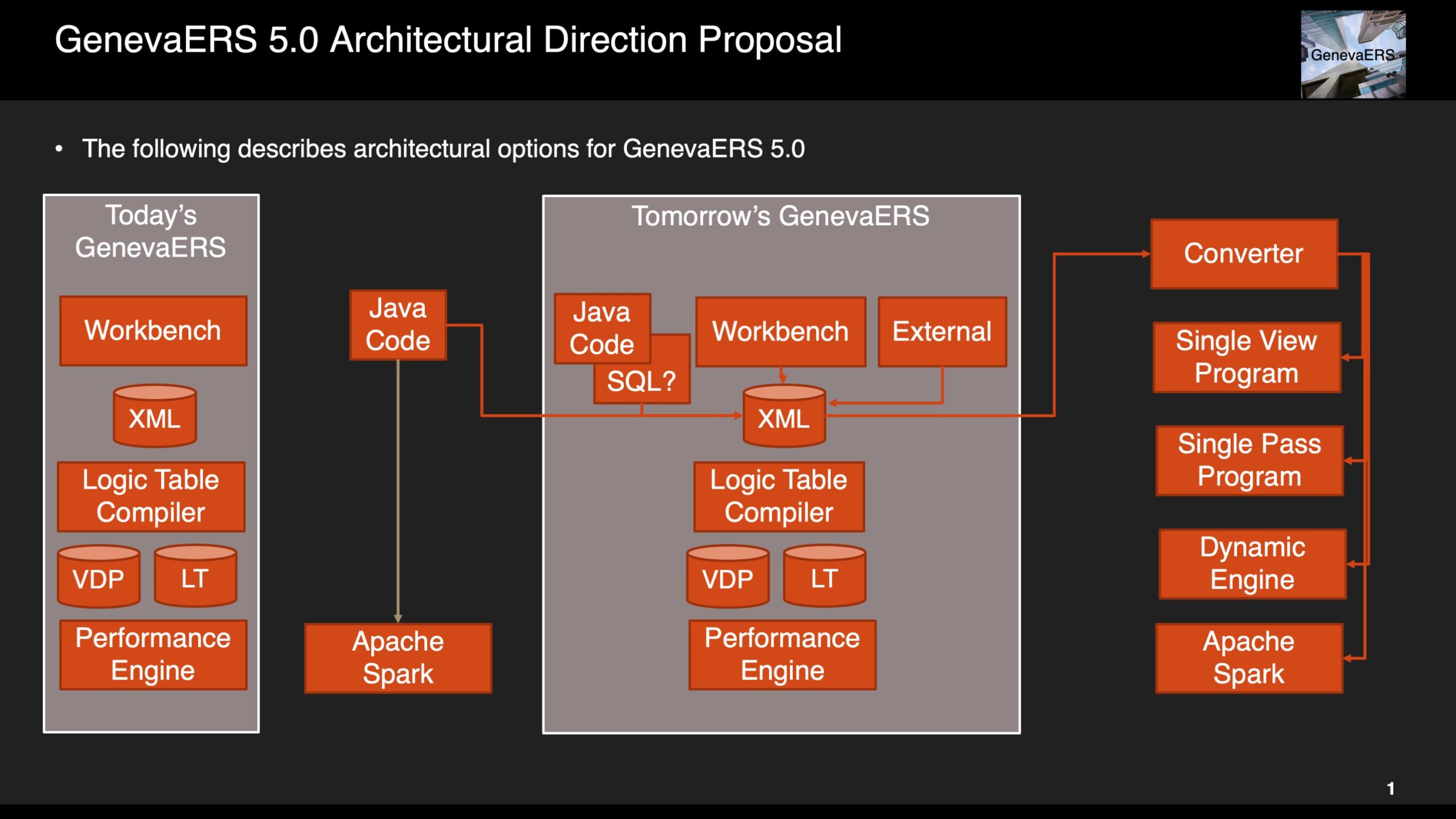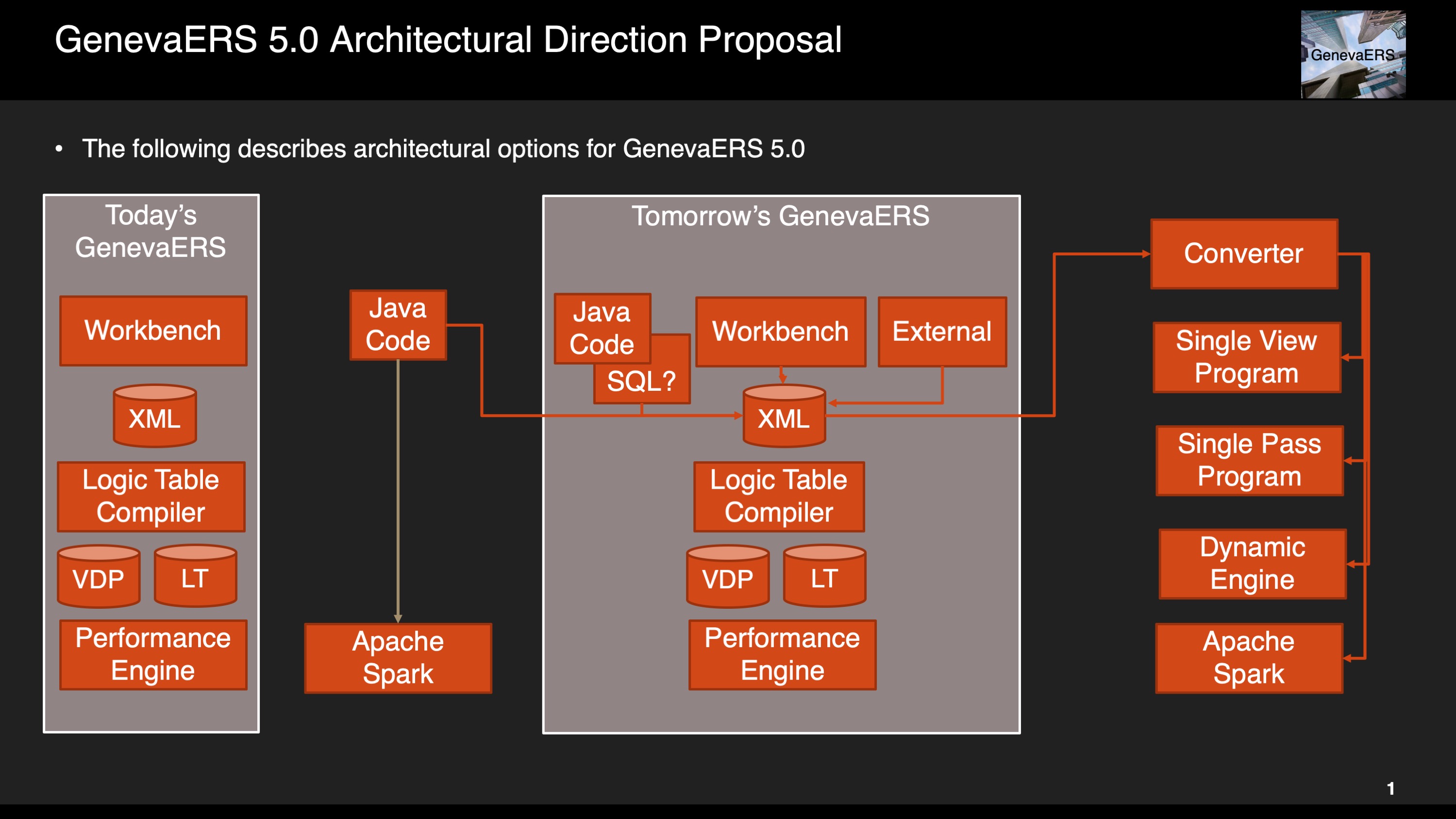
The following are some initial thoughts on the next version of GenevaERS as an Open Source project might go:
Workbench
Currently the only way to specify GenevaERS processes (called a GenevaERS “view”) is through the Workbench, which is a structured environment allowing specifications of column formats, values to be used in populating those columns, including the use of logic called GenevaERS Logic Text.
GenevaERS developers have known for years that in some cases a simple language would be easier to use. The structured nature of the Workbench is useful for simple views, but becomes more difficult to work with for more complex views.

Specific Proposals
In response, we propose enhancements to the front-end of GenevaERS for the following:
- Open up a new method of specifying logic besides the Workbench, initially Java.
- This language would be limited to a subset of all the Java functions as supported by the the extract engines.
- The current Workbench compiler would be modified to produce a GenevaERS logic table from the Java code submitted to it.
- Develop plug-ins for major IDE’s (Eclipse, Intellij) that highlight use of functions GenevaERS does not support in the language.
- GenevaERS Performance Engine Processes should be able to construct a VDP (View Definition Parameter) file from a mix of input sources.
Benefits
Doing this would allow:
- Storage of GenevaERS process logic in source code management systems, enabling all the benefits of change management
- Opening up to other languages; often extracts from GenevaERS repositories are more SQL-like because of the data normalization that happens within the repository
- Taking in logic specified for Spark and other execution engines which conform to GenevaERS syntax, providing higher performance throughput for those processes
- Begin to open the possibility of constructing “pass” specifications, rather than simply defined in execution scripting.
- Perhaps creation of in-line “exit” like functionality wherein the specified logic can be executed directly (outside the Logic Table construct).
Performance Engine
The GenevaERS Performance Engine uses the Logic Table and VDP file to resolve the GenevaERS processes (GenevaERS “views”).
Specific Proposals
Proposed enhancements include:
- Expanding today’s very efficient compiler to more functions, to support greater sets of things expressed in the languages. This would include things like greater control over looping mechanisms, temporary variables, greater calculation potential, and execution of in-line code and called functions within a view under the GenevaERS execution engine.
- If there is interest and capacity, we may even move in the longer term towards an alternative Java execution engine. This would be a dynamic java engine, similar to the GenevaERS extract engine today; not a statically created for specific business functions as discussed below.
Alternative Engines
Existing customers have expressed interest in alternative execution engines for SAFR logic, as demonstrated in the Initial Open Source Work: Metadata Translation. The following are approaches that can be taken to these requests:
View to Stand-alone Java Program: It is possible to consider creating utilities which translate from GenevaERS meta data to another language, each view becoming a stand alone program, which could simply be maintained as custom processes. This would provide a migration path for very simple GenevaERS Processes to other tooling, when performance is not important.
Multi-View Execution Java Program: A set of GenevaERS views (a VDP) could be converted to a single Java program, which produces multiple outputs in a single pass of the input file, similar to what GenevaERS does today. In other words, it is possible to look at how GenevaERS performs the one-pass architecture, isolates differing business logic constructs from each other, perform joins, etc., and write new code to do these functions. This would also provide performance benefits from learning from the GenevaERS architecture.
Dynamic Java Program: Today’s GenevaERS compiler which produces a Logic Table could be converted to produce a Java (or other language) executable. This might add the benefit of making the processes dynamic, rather than static. This can have benefits to changing rules and functions in the GenevaERS workbench, and some sense of consistent performance for those functions, and the potential benefit of growing community of GenevaERS developers for new functions.
Next Steps
These ideas will be discussed at an upcoming GenevaERS community call to gauge interest and resources which might be applied.

